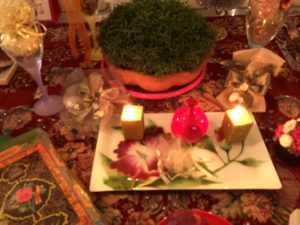
March 21st was the first day of spring. Judging by what we see outside here in New England, spring still seems far away.
For millions of people who observe the solar calendar in countries such as Iran, Afghanistan and parts of India, the first day of spring also means the first day of the New Year. This is called Nourooz (Nou=new, rooz=Day) and the current year is 1396.
I have many childhood memories about growing up in Iran and celebrating Nourooz. A few weeks before the holiday, a tradition called “Khanetekani” which literally means ‘shaking down the house’ begins. This is a ritual spring cleaning. Rugs are washed, closets and kitchen cabinets are organized and the house is cleaned inside and outside. The symbolism is more than just good hygiene.Cleanliness keeps the evil away and brings good energy inside the home, according to the Persian culture.
On Wednesday night before Nourooz, children line up in the streets of their neighborhood and make bon fires. They jump over the fire and sing a folkloric song, “my yellow color to you and your bright red color to me”. By jumping over the fire, you wish for all your impurities and illnesses to burn and you absorb the fire purity and brightness. This tradition also goes back to three thousand years ago from the time of Zoroastrians. Zoroastrian religion was one of the first religions established in the old Persia which is the current Iran. They worshiped Fire and believed in its purity.
On the day of Nourooz, the extended family will get together. Everyone wears their best and newest clothes and sits around the “Haft seen” table. The Haft seen table dates to 300-500 BC and displays an arrangement of seven items that begin with the letter “S” or “seen” in Farsi. (Farsi is the language of Iranians). These items symbolically correspond to seven creations and holy immortals protecting them.
- Sabzeh= barley or lentil sprouts symbolizing rebirth
- Sib= Apple, symbolizing beauty and health
- Sir= Garlic, symbolizing medicine and keeping evil away
- Serkeh= Vinegar, symbolizing age and patience
- Samanu= Sweet wheat pudding, symbolizing affluence
- Senjed= Fruit of Persian Olive tree, symbolizing love
- Somaq= Red sumac berries, Symbolizing sun and color of sunrise
Other items on the table may include:
- Silver coins, symbolizing wealth
- Mirror, self-reflection
- Bowl of water with a gold fish, symbolizing life within life
- Lit Candles, symbolizing enlightenment
- Decorated eggs, symbolizing fertility
The Nourooz celebration lasts for thirteen days. Sweet pastries are shared, crisp paper money is given to children by the relatives. The schools and work places all close. It is family time and relatives come and go.
On the last day of celebration, the thirteenth day, families visit parks or city outskirts and riverbanks to picnic. It is called "zisda be dar" or the thirteenth day outside. By spending the thirteenth day of the new year outside of your home, you will keep the bad fortune and evil away for the entire year.
Nourooz is not a religious or Islamic holiday but rather an ancient and cultural holiday. In 2009, UNESCO placed Nourooz on its list of cultural heritages, recognizing the importance of preserving the social practices, rituals and festive events.
Happy Nourooz to all of you!
By Dr. Peiman Mahdavi



